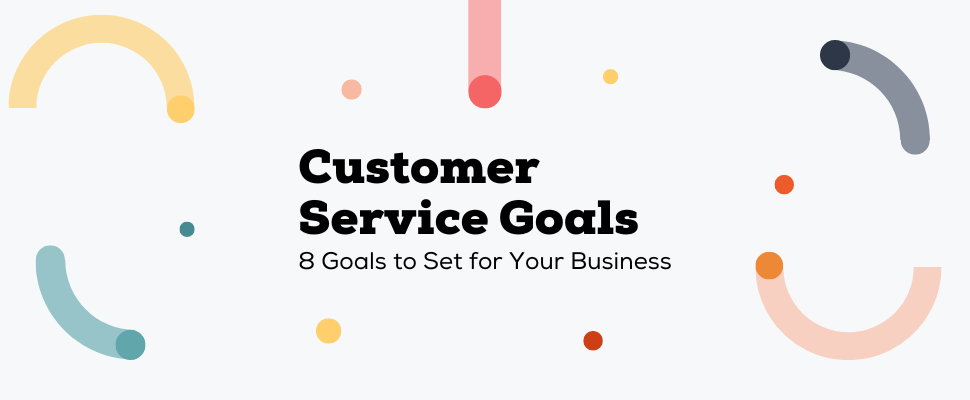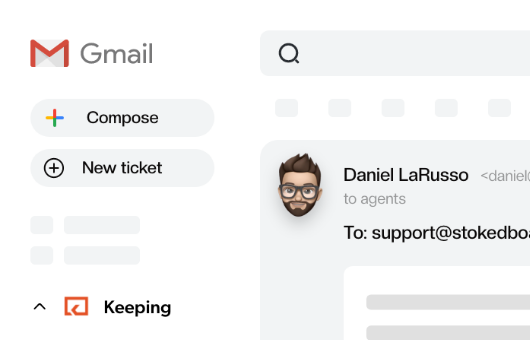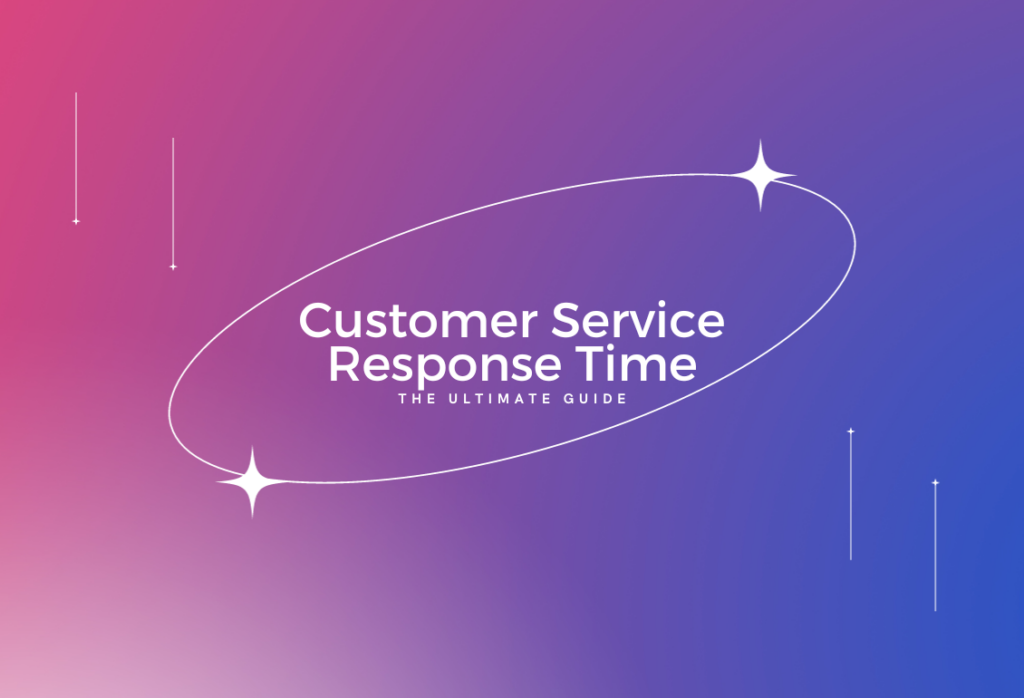
8 Customer Service Goals to Set for Your Business
Measurable customer service goals can tell you if you’re on track to improving customer service and earning more loyal and satisfied customers.
If you’re any business worth its salt, you’ll find that your customer service team is always evolving. In order to keep pace with changing customer expectations and a rapidly developing industry, companies must always strive to stay one step ahead of the curve.
But it’s hard to change constructively if you don’t know where you’re headed. Customer service teams may suffer from conflicting priorities if you don’t set clear customer service goals to give them a target.
Team that have explicit goals in place are much more likely to be able to improve their performance and meet rising standards.
Customer service goals can help you improve your customer service, earning more customer loyalty and improving retention. You also have the chance to raise the morale of your entire team, reducing agent turnover and enhancing employee performance.
The importance of setting customer service goals
Customer service is a core part of your brand’s promise to your customers. If customer service doesn’t come up to scratch, your customers will be unhappy and potentially leave your business in droves. Having customer service goals in place means your service team is always improving and delivering a high standard of service to customers.
Customer service goals are always aimed at enhancing the quality of service delivery.
Customer service goals give your entire customer service team a target to aim for. When everyone knows explicitly what is expected of them, their work becomes more focused and effective. Having goals in place is intrinsically motivating for customer service teams.
Setting goals gives your managers a way to measure individual team member’s performance, and identify any areas where additional support might be needed. You can use your customer service goals to reward any high-performing employees for their outstanding work.
Customer service goals means your business is not stagnant. It’s always responding to the needs of your customers and continuing to exceed their expectations.
What are SMART goals for customer service?
SMART goals in customer service are actionable goals since they are Specific, Measurable, Achievable, Relevant, and Time-bound. When you set customer service goals, you should make them SMART.
Here are the key characteristics of SMART goals:
- Specific – this means narrowing down exactly what you want to achieve with your goal. Instead of saying “improve customer service”, you’ll say you want to improve first response times.
- Measurable – this means knowing exactly when you will have achieved your goals. For example, “improve first response times by 10%” is a measurable goal.
- Achievable – this means setting a goal that you know your team can realistically attain. For example, saying “improve first response time by 10% by tomorrow” is not a realistic goal.
- Relevant – this means your goal should be something that is meaningful for your team to achieve. Working in customer service, increasing customer response times is relevant to delivering a better standard of service.
- Time-bound – this means setting goals that you want to achieve by a specific date. For example, “improving first response time by 10% in three months” is a time-bound goal.
How to set goals for customer service
Next, we’ll look at how you can set customer service team goals.
Understand where your team is falling short
In order to improve your customer service quality, you must know the areas in which your team is falling short. Are you receiving a low customer satisfaction score, for example, or are many customers complaining about the long wait times? It can be hard to study your imperfections, but you must know what you want to improve before you can raise the standard.
Define how customer service is measured
Metrics and KPIs help you define how customer service quality is measured. These are all part of creating SMART goals that send your team off in a specific direction. Metrics and KPIs tell you whether customer service quality is improving and how close your team is towards meeting its goals.
Work together with your team to set goals
Customer service team members are likely to have strong ideas about what you can do to improve the experience for customers. When you involve service team members in setting goals, they are more invested in the process and have a sense of personal accountability.
Have individual and team goals
It’s best to set goals for your wider team to accomplish and goals for individual team members to strive for. You can set goals on a monthly, quarterly or annual basis to keep your team motivated and aligned with the business’s wider objectives.
Invest in software that can help you measure goals
Customer service software like Keeping is specifically designed to help you keep track of your most important customer service goals. You can track first response time, volume of requests, and how each of your team members responds.
8 customer service performance goals examples
Here are some customer service goals examples.
1. Improve customer satisfaction
KPI: Customer satisfaction score (CSAT)
A popular way to measure how happy a customer is with your service is to ask them for their customer satisfaction score. A high CSAT means customers are very satisfied with your service and consider your business to be doing a good job. CSAT usually measures customer satisfaction with a particular experience, sent out through a survey after an interaction with one of your agents.
A good method of finding out whether you’ve improved customer service overall is to measure CSAT as your customer service goal. Raising CSAT must happen agent-side, whether that’s training in how to better solve customer problems, or developing a more polite and friendly customer manner.
CSAT is the responsibility of everyone in your team and reflects the experience from the minute the customer first gets in contact to when they close the ticket with your company.
2. Improve Net Promoter Score
KPI: Net Promoter Score (NPS)
Net Promoter Score is another way of measuring customer happiness, specifically how likely they are to recommend your brand to others, which makes it a good customer service goal. When a customer has an NPS of nine or higher, they are considered a promoter of your business.
Every business wants to earn more promoters, and the way to do that is to raise your standard of service. This might involve going the extra mile for customers, or taking the time to send out personalized emails thanking them for their business.
Customer advocacy is incredibly important because it’s a way of earning referrals for your business. Customers are so happy with the service they received, they are willing to share your brand with colleagues, friends and family. Customers referred by other customers have a 37% higher retention rate than other customers.
When a business wins over more promoters, they can spend less in other areas like marketing because they have free advertising from customers, making customer service a driver of profit.
3. Decrease First Response Time
KPI: First Response Time (FRT)
When customers send your business a message, they are waiting on tenterhooks for a first reply. If they don’t get one for a long time, they may send your business another message or worse, give up and turn to your competitor. That’s why decreasing First Response Time is critical to improving customer service overall and a vital customer service goal. Businesses reported that they lost 75% of customers due to long wait times.
To decrease FRT, your agents must get better at handling customer tickets. The more tickets they can get through in the same amount of time, the lower the FRT will be for customers. Alternatively, you can hire more agents, or organize more cover during your busiest periods.
We wrote a whole blog post on why it’s critical to acknowledge receipt of customer emails.
4. Decrease Average Handle Time
KPI: Average Handle Time (AHT)
Customers want you to solve their issues as quickly as possible, especially if their query is simple in nature. Average Handle Time is the overall time it takes for an agent to solve an issue from start to finish, and naturally the shorter the time the better. 89% of customers voted speed of resolution as the most important aspect of a customer service experience.
Reducing AHT may involve improving the ways that agents collaborate with each other on solving customer tickets. If an agent is waiting for a response from a colleague, the customer ticket is left hanging with the customer growing more and more frustrated.
Training may be needed to help agents get better at diagnosing customer problems, reducing the time it takes for them to solve the ticket. If you find your customers are waiting on hold for a long time, you could implement a call-back feature so customers aren’t stuck on the phone.
Decreasing AHT may require significant effort over the long-term but is worth it for the gains in customer experience.
5. Improve employee happiness
KPI: Employee Net Promoter Score (ENPS)
Happy service reps are happy customers. When agents are thriving and fulfilled in their role, this translates to better service for customers. Companies with happier employees outperform the competition by 20%.
Agents are more resilient, able to deal with difficult situations more effectively, and listen more empathetically to customers. The way to measure employee happiness is with Employee Net Promoter Score, asking whether they would recommend your company as a place to work.
Improving employee happiness is very tricky. You’ll have to work hard to enhance the employee experience. This can range from anything to offering more breaks, providing the best tools for them to work with, and rewarding good performance.
A positive company culture can’t be beat, and is all part of what your brand has to offer employees.
When employees are motivated and engaged, agent turnover is lower and agents stay in their jobs for longer. This all positively impacts your bottom line as you have to spend less money on training new agents.
6. Create moments of delight for customers
If your business is already satisfying its customers, you may be wondering how you can take it a step further to create moments of true delight. Satisfaction is all well and good, while delight gets customers talking and makes them remember your brand. Creating delight doesn’t have to cost the earth – in fact, it can be something as small as including a hand-written thank you note in your customer’s order.
Some companies allocate agents a monthly budget which they can spend on delighting customers. Your business could follow suit and empower your agents to spend up to a certain amount every month.
Customer appreciation is a surefire way to earn more customer loyalty and involves going that extra mile for customers. 91% of customers said they are more likely to do business with companies that appreciate them.
If you want to stop customers defecting to the competition, give them an experience that they can get nowhere else.
7. Invest in self-service resources for customers
KPI: Self-service usage
Another way to improve your customer service quality is to embolden customers to help themselves. Customers who avail themselves of your self-service resources won’t need to contact support, so one of your goals should be to invest in the availability of tools such as a knowledge base or chatbot.
Self-service is all about deflecting customer tickets that would otherwise have to be solved by a live agent. 88% of customers expect brands to have an online self-service portal, so you’d be meeting customer needs by providing them with self-service. When more customers are using self-service, this frees up your agents to concentrate on providing quality service to the customers who really need it.
You’ll need to spend time either creating FAQs, knowledge base articles, and video tutorials, or training your chatbot to answer basic questions. The major benefit of self-service is that customers can find their answers instantly, drastically reducing your time to first response.
Self-service is a massive cost-saver for customer service, eliminating the need to hire more agents through ticket deflection.
8. Streamline customer contact channels
KPI: Customer Effort Score (CES)
No matter the method of contacting you, it should be ridiculously easy for customers to get in touch. Companies that hide their contact details away deep in their website earn themselves more angry and frustrated customers than those who made it plain as day how to contact support.
Hiding your contact details suggests your company doesn’t care about its customers and makes customers much more disloyal.
Making it easy for customers to contact you doesn’t mean being present on every single channel. Rather, it means doing just a few channels well so customers can be assured of a relatively immediate response.
If your business is spreading itself too thin, it may be time to think about getting rid of a few channels. Find your channels that are getting the most inquiries, such as Facebook Messenger and live chat, and concentrate your efforts on bringing those up to scratch.
Wrapping up
Companies who set goals for their customer service team outperform the competition and provide a higher standard of service for their customers. When everyone on your customer support team is oriented towards the same north star, they are more motivated to work towards a common purpose and put in that extra effort to win customers over.
Without goals, you can’t tell if your service level is improving over time. You won’t be able to reward agents and teams for their hard work, because you won’t be able to quantify anyone’s achievements. Measurable customer service goals can tell you if you’re on track to improving customer service and earning more loyal and satisfied customers.
When you meet your customer service goals, it’s a feeling like no other. You have tangible evidence that your business is exceeding expectations.
When choosing your customer service goals, it’s important to make them SMART. If your goals aren’t actionable, they may end up getting ignored. Goals that are measurable and specific stand a better chance of getting met than goals which are vague and unfocused.
Join 150+ teams that are sharing inboxes with us
The easiest way to upgrade your shared Gmail account. There’s no credit card is required.






